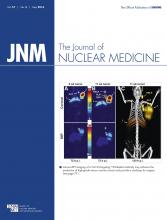Abstract
AMG 110, a bispecific T cell engager (BiTE) antibody construct, induces T cell–mediated cancer cell death by cross-linking epithelial cell adhesion molecule (EpCAM) on tumor cells with a cluster of differentiation 3 ε (CD3ε) on T cells. We labeled AMG 110 with 89Zr or near-infrared fluorescent dye (IRDye) 800CW to study its tumor targeting and tissue distribution. Methods: Biodistribution and tumor uptake of 89Zr-AMG 110 was studied up to 6 d after intravenous administration to nude BALB/c mice bearing high EpCAM-expressing HT-29 colorectal cancer xenografts. Tumor uptake of 89Zr-AMG 110 was compared with uptake in head and neck squamous cell cancer FaDu (intermediate EpCAM) and promyelocytic leukemia HL60 (EpCAM-negative) xenografts. Intratumoral distribution in HT-29 tumors was studied using 800CW-AMG 110. Results: Tumor uptake of 89Zr-AMG 110 can be clearly visualized using small-animal PET imaging up to 72 h after injection. The highest tumor uptake of 89Zr-AMG 110 at the 40-μg dose level was observed at 6 and 24 h (respectively, 5.35 ± 0.22 and 5.30 ± 0.20 percentage injected dose per gram; n = 3 and 4). Tumor uptake of 89Zr-AMG 110 was EpCAM-specific and correlated with EpCAM expression. 800CW-AMG 110 accumulated at the tumor cell surface in viable EpCAM-expressing tumor tissue. Conclusion: PET and fluorescent imaging provided real-time information about AMG 110 distribution and tumor uptake in vivo. Our data support using 89Zr and IRDye 800CW to evaluate tumor and tissue uptake kinetics of bispecific T cell engager antibody constructs in preclinical and clinical settings.
Footnotes
↵* Contributed equally to this work.
Published online Feb. 4, 2016.
- © 2016 by the Society of Nuclear Medicine and Molecular Imaging, Inc.







